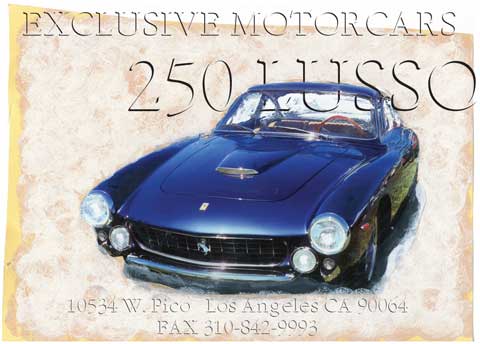
By Wallace Alfred Wyss
I remember visiting a guy in Newport Beach about 20 years ago who was a Can-Am racer who had just bought a Ferrari 250GT Lusso. I felt sorry for him because , as far as Ferrari 250s go , that model was known at the time as strictly a boulevard car with no racing potential, and therefore little investment potential. Now that Lussos are worth between $300,000 and $500,000 I no longer feel sorry for the old Can Am-er.
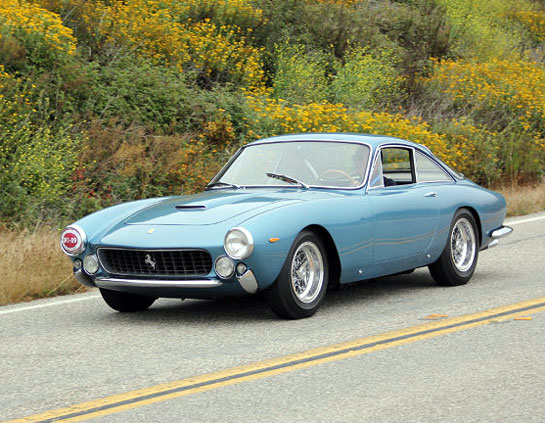
Notched front bumpers were created to protect the front turn signals. The bumpers would be much more expensive to replace than the lights, however. Photo by Hugues Vanhoolandt.
The Lusso prototype, chassis 3849GT, was unveiled at the 1962 Paris Auto Show, and was an attempt to build a sort of luxury car that would be more refined than the already existing 250 SWB (short wheelbase berlinetta).
The Lusso was a luxurious car with full leather, and a sort of luggage tray behind the two bucket seats to carry fitted luggage if you were planning on grand touring. The bodywork was by Pininfarina. Scaglietti, Ferrari’s in house coachbuilder, manufactured the coachwork and created another Lusso prototype, chassis 4053 GT, with changes that would make the show car more suitable for production. The production run itself was very short, beginning in January of 1963 and ran to about August of 1964.
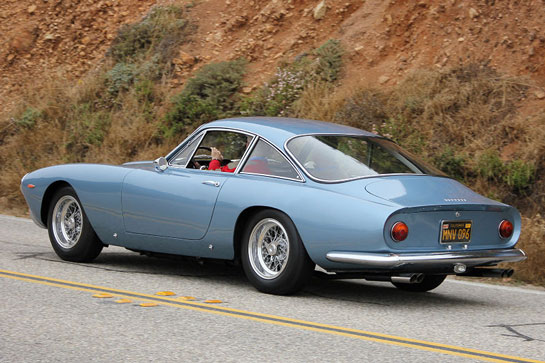
The Ferrari Lusso is one of the most perfectly proportioned of all Ferraris. Perhaps its beauty is just too perfect, too boulevardier, for there is always something whispering “GTO” in one’s ear. Photo by Hugues Vanhoolandt.
One reason the Lusso had little competition potential was that the body was steel with only the doors, hood, and trunklid wrought from aluminum. The grille and headlights were similar to those on the SWB, but the front fenders were narrower and elongated. Really clever were the chrome bumper guards that swept up to protect the body and nestle the front turn signals protectively. A bit of a mystery was the scoop which might have been necessary to clear the carburetors but appears to be blocked off. Having something fake on a Ferrari is unusual but, hey, sometimes you need a scoop to clear a carburetor but don’t really need any air intake (which, if truth be told, is a problem in the rain)
The rear roofline was similar to some Superamerica prototypes, a very thin set of rear pillars. The tail had the Kamm effect spoiler built in. Really setting the style for a generation of Ferraris were the flat surfaced rounded edge turn signals.
The chassis was descended from the very successful race car, the Ferrari 250 GTO, with the same wheelbase of 94.5 inches (2400mm). which is one reason why, when 250GTOs began rocketing in price some shabby Lussos were bought to convert to 250GTO bodywork. The racing potential was hurt by having the engine further forward compared to other 250s, more room inside but bad for weight distribution and cornering.
Lusso engines are identified as the Type 168/U. The block was common to all 250s. Some bits such as the valves and crankshaft came from the Ferrari 250 SWB parts bin, others like the cylinder heads and pistons, came from the strictly touring only model, the Ferrari 250 GTE. The result was a very solid 250 horsepower at 7000 rpm, which made all the right sounds but was nowhere near powerful enough to make it a racer like the 250 GT SWB.
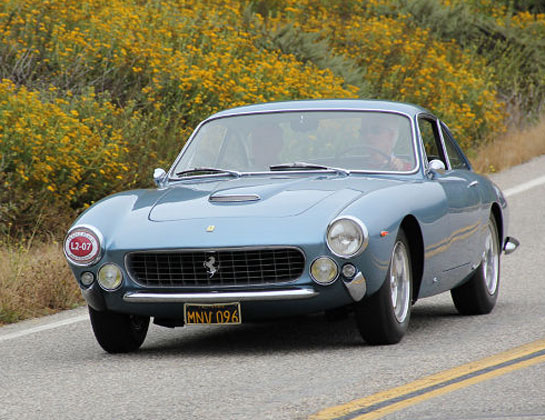
The hood scoop is ornamental. This decision by Pininfarina to make it non functional is criticized by the author but probably motivated by real world concerns of water ingestion. Photo by Hugues Vanhoolandt.
The instrument panel is controversial even four plus decades later because the supplemental gauges are in front of the driver and the speedometer and tachometer in the center of the dash, which must have been some scheme to make it possible to adapt the car more easily to right drive but is disconcerting.
Six to ten Lussos were delivered with British calib instruments (refers to mph, psi, etc. calibration of instrumentation rather then km/h, Centigrade, etc.) Naturally RHD British versions are rarer on the ground and should be worth more, so those Yanks that bought a RHD version stateside can now profit by selling it for more on the Old Sode or in Australia.
One of the rarest is that built especially for the owner of Pininfarina, Battista Pininfarina himself. His car had a different roofline and different lighting. His car was even different from one side to th other–common in clay models where you want to get “two for the price of one” in seeing what an idea looks like in the full size car. It was displayed at the 1963 London Motor Show.
One British consultant to Ferrari on race cars disputed the oft-quoted production number of 450 plus and painstakingly poured over factory records until he logged around 350 Lussos, which, on numbers alone, makes it a very rare car, about 5 or 6 times rarer than a Mercedes Gullwing. According to the website Ferrari-ForSale the first production Lusso was S/N 4103 GT while they say the last one was 5955GT.
The image of Lussos as a namby pamby tourer was improved recently when one that belonged to a very memorable owner , Steve McQueen, was sold for $2.31 million, far beyond what they usually sell for.
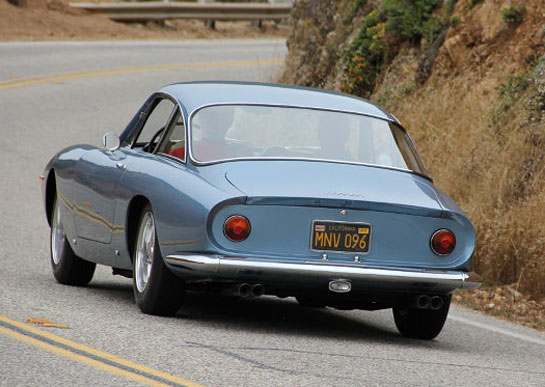
The Lusso has a Kamm effect tail, typical of many of the factory race cars of the era. It was the first to initiate that style taillamp on a Ferrari. Photo by Hugues Vanhoolandt. Photo by Hugues Vanhoolandt.
The argument that the Lusso is “the most beautiful street Ferrari” is strong. There is a longer hood, than tail, which is part of the grand touring tradition. It has a Kamm effect tail, typical of many of the factory race cars of the era. It was the first to initiate that style taillamp on a Ferrari. It has just the right amount of chrome, not enough to be garish but just enough to highlight the paint, especially in a dark-colored version. Plus the fact the Lusso has not dated; not a whit. It is a simple timeless design depending not on any momentarily popular trend of the time (remember the strakes on the side of the ‘80s Testarossas?) but on its beautiful shape for its appeal.
If you can only own one V-12 Ferrari, and want it to be as beautiful as it is fast, this could be the one….
The illustrator: Wallace Wyss, of Ontario, CA, says a 12? x 18? print of the painting shown here, sans lettering, is available through www.albaco.net
I will send you guys a few images of Peter Gidding’s 250 Lusso that he races. A beautiful car. I’ll be back in the states Monday and will send Tuesday. Nice article.
Hi Pete:
The first production Lusso sold was s/n 4213 GT. This is the car owned by Peter Giddings today. S/N 4103 GT is, and always has been, a SWB California now in Connecticut. Lusso 4213 GT went to Jacques Swaters as a new car and was sold to Leon Dernier who had it converted into a race car which it is today. I drove this car three years ago in Switzerland and it reminded me very much of earlier drives I had in 250 GTOs — very close to the same sound, feel, and thrill of driving a GTO. A remarkable Lusso.
Regards,
Alan
This is the first Ferrari i ever took note of or read about.
It was in Road and Track magazine and i remember feeling that everything was
right on this car, except perhaps the Kamm tail, but opinions….. why have them??
What a joy to have come across this site… thanks for what you do… (-:
One of the subtle but elegant designs on the Lussos is the way the curves of the front fender and rear fender cross each other along the top of the door. It’s hard to see in pictures but in person it is a magnificent detail.
About 25 or 30 years ago, a friend in New Orleans owned a Lusso he was getting discouraged with. Was ready to sell for $7000 or $8000. Asked him to please give me first refusal. He didn’t! Another one of those that got away.
Alas, Mike, those “rights of first refusal” deals are hard to keep in force. I remember when I was buying old Ferraris and other collector cars, I would surprise the owner out of the blue with a cashier’s check for what I thought the car was worth, give them a xerox copy of it and tell them the check was “only good for two days.” Do you think they tried to remember their friends who they promised to sell the car to if they ever got an offer? No way–I had them totally concentrating on whether the bank would cash the check. Such are the realities of the car collector world…
Great article on what I believe is the most beautiful Ferrari ever made. I remeber seeing my first example of this car in the paddock at Brands Hatch at the Boxing Day (December 26th) race meeting in 1963.The car belonged to banker Maurice Baring who seemed have the uncanny ability to get his car into the most prominent place at every event. See also my story about the FCA Annual Meet in VT https://velocetoday.com/archives/12638 which includes a picture of a 250 GT Lusso next to Lee Harrington’s one-off 1963 250 GT Speciale Berlinetta (S/N: 4385) which has the front end of a 250 GTO and the rear end of a 250 GTL. Although the author correctly states that the 250 GT Lusso was not suitable for racing, the body design was used as the basis for the longer 1963 330 LMB racecar.